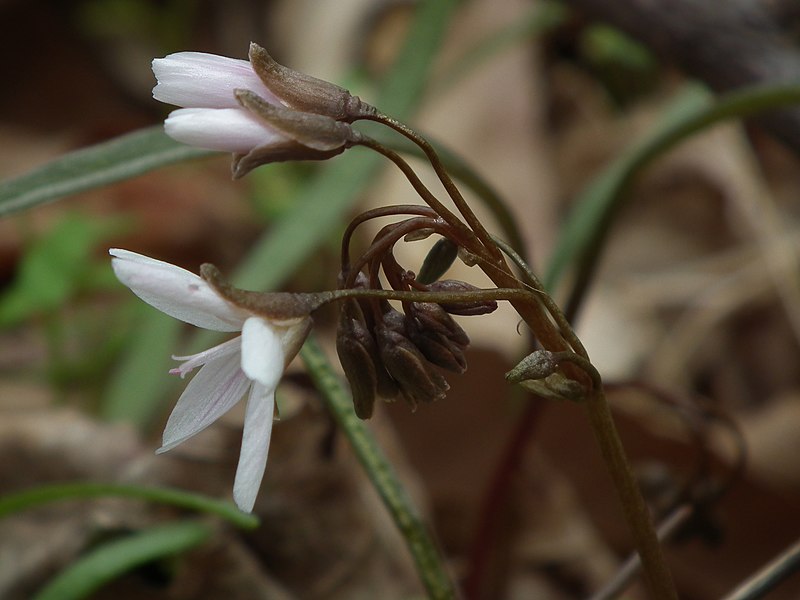
One of our early woodland flowers, beating even the Bloodroots. These were blooming along the Trillium Trail in Fox Chapel.
For a full description, see the Claytonia virginica reference page.






One of our early woodland flowers, beating even the Bloodroots. These were blooming along the Trillium Trail in Fox Chapel.
For a full description, see the Claytonia virginica reference page.






One of the garden favorites that have become occasional urban weeds, Moss Rose can pop up just about anywhere. This one was growing out of the asphalt along the curb on a back street in Brookline. We can see its family resemblance to the much more common Purslane (Portulaca oleracea): both are succulent plants, mostly flopped along the ground (“prostrate,” as the botanists would say), with five-petaled flowers. But the flowers of P. grandiflora are, as the name implies, very large in proportion to the rest of the plant, and they come in many colors; volunteers are most commonly electric magenta like this one. The leaves of P. grandiflora are more linear, as opposed to the elliptical leaves of P. oleracea.

Purslane is all over the world, and whether it came to America with Europeans or was native here is an open question. We most often find it in city neighborhoods; it especially likes brick sidewalks. These unusually lush specimens were growing in the little parklet at the end of the Birmingham Bridge on the South Side.
We last mentioned Purslane in 2012, so we repeat what we said then:
This tiny prostrate weed is a close relative of the colorful Moss Roses we grow in gardens—the thick, fleshy red stems and succulent leaves show the relationship clearly. The little yellow flowers open only in the morning, and only in bright sunlight. Purslanes can grow almost anywhere they get a foothold, and can survive being pulled up and thrown away to root elsewhere. In the city they are very common crack-in-the-sidewalk weeds.

Gray describes the genus and the species:
PORTULACA [Tourn.] L. PURSLANE. Calyx 2-cleft; the tube cohering with the ovary below. Petals 5, rarely 6, inserted on the calyx with the 7-20 stamens, fugacious. Style mostly 3-8-parted. Pod 1-celled, globular, many-seeded, opening transversely, the upper part (with the upper part of the calyx) separating as a lid. — Fleshy annuals, with mostly scattered leaves. (An old Latin name, of unknown meaning.)
P. olerácea L. (COMMON P.) Prostrate, very smooth; leaves obovate or wedge-form; flowers sessile (opening only in sunny mornings); sepals keeled; petals pale yellow; stamens 7-12; style deeply 5-6-parted; flower-bud flat and acute. — Cultivated and waste grounds; common.—Seemingly indigenous westw. and southwestw. (Nat. from Eu.)

Among the earliest woodland flowers, Spring Beauties are abundant and cheerful when the rest of the woods is just waking up. These flowers were blooming in the middle of April along the Trillium Trail in Fox Chapel.
Gray describes the genus and the species:
CLAYTONIA [Gronov.] L. SPRING BEAUTY. Sepals 2, ovate, free, persistent. Stamens 6, adhering to the short claws of the petals. Style 3-cleft at the apex. Pod l-celled, 3-valved, 3-6-seeded. — Perennials, our two species sending up simple stems in early spring from a small deep tuber, bearing a pair of opposite leaves, and a loose raceme of pretty flowers. Corolla rose-color with deeper veins, opening for more than one day. (Named in honor of Dr. John Clayton, one of our earliest botanists, who contributed to Gronovius the materials for the Flora Virginica.)
C. virginica L. Leaves linear-lanceolate, elongated (7-16 cm. long).— Moist open woods, N. S. to Sask., and southw.; common, especially westw. and southw.
This tiny prostrate weed is a close relative of the colorful Moss Roses we grow in gardens—the thick, fleshy red stems and succulent leaves show the relationship clearly. The little yellow flowers open only in the morning, and only in bright sunlight; we shaded the plants momentarily to take these pictures at midday without the harsh glare. Purslanes can grow almost anywhere they get a foothold, and can survive being pulled up and thrown away to root elsewhere. In the city they are very common crack-in-the-sidewalk weeds. The plant above was growing from a crack on the top of a low concrete wall; the one below (magnified many times—the boulders in the picture are ordinary gravel) was growing in a gravel parking lot. Both were a little west of Cranberry, blooming in early September. Purslane was once commonly used as a salad green, valued for its texture rather than its famously bland taste.
We are experimenting with a camera we bought used for $20 that claims to be able to focus as close as an inch from the subject. So far, we are pleased with the results.
Gray describes the genus and the species:
PORTULACA [Tourn.] L. PURSLANE. Calyx 2-cleft; the tube cohering with the ovary below. Petals 5, rarely 6, inserted on the calyx with the 7-20 stamens, fugacious. Style mostly 3-8-parted. Pod 1-celled, globular, many-seeded, opening transversely, the upper part (with the upper part of the calyx) separating as a lid. — Fleshy annuals, with mostly scattered leaves. (An old Latin name, of unknown meaning.)
P. olerácea L. (COMMON P.) Prostrate, very smooth; leaves obovate or wedge-form ; flowers sessile (opening only in sunny mornings); sepals keeled; petals pale yellow; stamens 7-12 ; style deeply 5-6-parted; flower-bud flat and acute. — Cultivated and waste grounds; common.—Seemingly indigenous westw. and southwestw. (Nat. from Eu.)